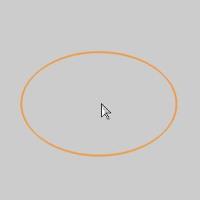 Ellipse
Ellipse
Introduction
This topic will explain where to find the Ellipse function, and explain the options found in it. This topic will also give a brief description of Dynamic Drawing, the Snap Increment function, explain Ellipse creation with quick steps, and provide links to related topics.
The Ellipse Function
The Ellipse function is used to create ellipses using sketching, data entry, or a combination of both.
Dynamic Drawing
This function supports Dynamic Drawing which allows you to use a combination of sketching and data entry to create the entities. After initially sketching the entity, it becomes an active entity, which is an entity that is in Modify Mode. Entities in Modify Mode display in the current Entity color, but displays with a greater line thickness to make them easier to identify. Active entities can be modified using data entry. The benefit of Dynamic Drawing is that you can quickly sketch a point to get the approximate result and then use data entry to update to the exact dimensions, and coordinate values as needed.
|
Entities in Modify Mode |
Final Entities |

|

|
In the images above, we see entities which are still in Modify Mode, followed by those same entities after they are finalized.
Snap Increment
This function support the use of the snap increment when selecting the location of the entities. The snap increment allows you to get precise results when using mouse selection and helps to reduce data entry modifications.
To learn more, view Snap Increment.
Navigation
To open Ellipse:
-
In the Shapes group, of the Create 2D ribbon, click
 Ellipse.
Ellipse.
The parameters display in the Data Entry Manager.
The Data Entry Parameters
Parameters
-
Major Axis - sets the X-axis dimension of the ellipse.
-
Minor Axis - sets the Y-axis dimension of the ellipse.
-
Start Angle - sets the angle, from the X-axis, at which the ellipse begins.
-
End Angle - sets the angle, from the X-axis, at which the ellipse ends.
-
Break into Arcs
![]() Select the check box to create the ellipse with multiple entities based on the Resolution value.
Select the check box to create the ellipse with multiple entities based on the Resolution value.
![]() Clear the check box to create a single entity ellipse.
Clear the check box to create a single entity ellipse.
Origin
The Origin determines the coordinate location of the center of the ellipse using the XYZ coordinates of the active UCS. This value can be set using data entry or mouse selection. When using mouse selection, the snap increment applies.
-
X - is the X-axis location of the ellipse origin.
-
Y - is the Y-axis location of the ellipse origin.
-
Z - is the Z-axis location of the ellipse origin.
-
Break into Arcs
![]() Select the check box to create the ellipse with multiple entities based on the Resolution value.
Select the check box to create the ellipse with multiple entities based on the Resolution value.
![]() Clear the check box to create a single entity ellipse.
Clear the check box to create a single entity ellipse.
- OK - finalizes the function.
- Cancel - exits the function.
Quick Steps - Ellipse
Dynamic Drawing Method
- Open the function and click a snap point or anywhere in the graphics area to set the origin of the ellipse.


You can modify the snap increment value or turn it off when selecting the origin location using the mouse.
This is now the active entity, which means that it is not fully defined. - Dynamic Drawing allows you to update the Data Entry parameters to modify the active ellipse.
After updating the Data Entry parameters, to finish the active entity, you can click OK or start sketching the next ellipse.
When you don't need to update the Data Entry parameters, you can just click to start the next ellipse.
- Repeat this process for all ellipses that you want to create.
- To close the function, click Cancel.
Data Entry Method
You can also create ellipses using only data entry.
- Open the function and define all Data Entry parameters needed for the first ellipse.
- Click OK to create the ellipse.
- Update the Data Entry parameters, and click OK to create the next ellipse.
- Repeat this process for as many ellipses as needed.
- To close the function, click Cancel.
Related Topics
The CAD Overview






